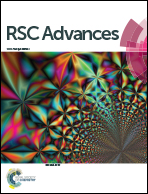An ultrasensitive colorimetric strategy for protein O-GlcNAcylation detection via copper deposition-enabled nonenzymatic signal amplification
Abstract
O-GlcNAcylation is a very important post-translational modification of nucleocytoplasmic proteins. Aberrant O-GlcNacylation has been found in a variety of human diseases including many types of cancers, diabetes, and Alzheimer's disease. However, analysis of protein O-GlcNacylation still remains a great challenge due to its low levels and labile nature. Herein, a highly sensitive and reliable colorimetric method is developed by use of wheat germ agglutinin (WGA) lectin for specific recognition of O-GlcNAc and gold nanoparticle (AuNP)-catalyzed copper deposition for signal amplification. In presence of the target molecule, AuNP is specifically introduced onto the sensing surface and then catalyzes the copper deposition. An Au@Cu core–shell structure is produced from the deposition. The obtained copper shell on AuNP is dissolved by FeCl3 due to the oxidation–reduction reaction between copper and Fe3+, resulting in Cu2+ and Fe2+, which subsequently form a red coordination complex in the presence of bathophenanthrolinedisulfonic acid disodium salt (BPT2−). Thus, the amount of the red complex is proportional to the level of O-GlcNAc. Qualitative O-GlcNAc detection is realized by direct readout with the naked eye, while the quantitative analysis is achieved by measurement of the absorbance using a UV-Vis spectrophotometer. With increasing time, more and more copper is deposited on the surface of AuNP, thus achieving significant signal amplification. Under optimal conditions, an ultralow limit of detection (LOD) down to 0.02 pg mL−1 is achieved with GlcNAc-conjugated BSA as a model analyte. The developed platform was also successfully applied to analyze O-GlcNAcylation levels in prostate cancer cell line PC-3 and normal cell line RWPE-1. The results obtained by the proposed method are in good agreement with the data from protein microarray assays, demonstrating its great potential for sensitive and reliable O-GlcNAcaylation detection in fundamental research and in cancer diagnosis.


 Please wait while we load your content...
Please wait while we load your content...